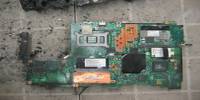In planes, gas turbine engines create thrust by taking in air, heating it to extremely high temperatures in a combustion chamber, and then exhausting it at high speeds.
Small inorganic particles, like as volcanic ash, are taken in with the air as they function. These particles melt in the combustion chamber’s high-temperature zones and solidify on the engine’s colder zones, such as the turbine blades.
These droplets solidify and build on the gas turbine’s surface over time, deforming the blades and blocking cooling holes, reducing the engine’s performance and longevity. While it cannot avoid the deposition phenomenon, engineers can use predictions to help build and alter engine designs.
Determining how molten droplets solidify in contact with a cooled surface is one of the most important parts of the deposition process, and an accurate simulation of this process is critical to understanding the process.
A group of Japanese scientists devised a model that can swiftly and correctly mimic the solidification of a single molten droplet on a flat surface, according to a paper published in the International Journal of Heat and Mass Transfer.
Their technique may be used to construct models that can anticipate the deposition process in jet engines because it does not require any prior information to set up.
Dr. Koji Fukudome and Prof. Makoto Yamamoto of Tokyo University of Science, Dr. Ken Yamamoto of Osaka University, and Dr. Hiroya Mamori of The University of Electro-Communications made up the research period.
There is no universal model for predicting depositions. Therefore, when considering the deposition of a certain droplet, a model is created by conducting experiments in advance, and numerical predictions are made. This study is expected to be a pioneer in the development of a universal deposition model.
Dr. Koji Fukudome
The novel approach replicates the solidification process by incorporating droplet dynamics and heat transfer between the hotter droplet and the colder surface, as opposed to prior models that assumed the surface to remain at a constant temperature.
“We have been simulating droplet impact, but we could not ignore the difference from the experiment. In this study, we thought that taking into account the temperature change of the colliding wall surface would be consistent with the experiment,” explains Dr. Fukudome.
The researchers chose a mesh-less moving particle semi-implicit (MPS) technique, which did not require repeated calculations on each grid, to create a less computationally costly model.
The MPS approach has been widely used to simulate complex flows and is based on fundamental equations of fluid flow (such as the incompressible Navier-Stokes equations and mass balance conservation equations).
Meanwhile, the temperature change inside the substrate was calculated using the grid-based approach, allowing us to combine the particle-based and grid-based methodologies in one method.
The researchers used this method to model the solidification of a molten tin droplet on a stainless steel substrate. The model functioned admirably, accurately replicating the solidification process observed in trials.
The simulations also gave a detailed look at the solidification process, highlighting the droplet’s spreading behavior and temperature distribution when it came into contact with the solid surface.
Their simulations revealed that the thickness of the liquid film created after the molten droplet made contact with the surface affects solidification.
Solidification begins as the liquid film expands on the surface, and it was first noticed near the surface at the edge of the liquid layer. Solidification progresses as the liquid film spreads and becomes thinner until the entire film is transformed into solid particles.
These findings are an advance over current solidification models, and the team is optimistic that their present method may be applied to more complex deposition models.
“There is no universal model for predicting depositions. Therefore, when considering the deposition of a certain droplet, a model is created by conducting experiments in advance, and numerical predictions are made. This study is expected to be a pioneer in the development of a universal deposition model,” Dr. Fukudome remarks.
Engineers and scientists will have a better knowledge of the complicated deposition phenomena as a result of this research, and jet engine designs will be changed to be safer and more long-lasting.
















